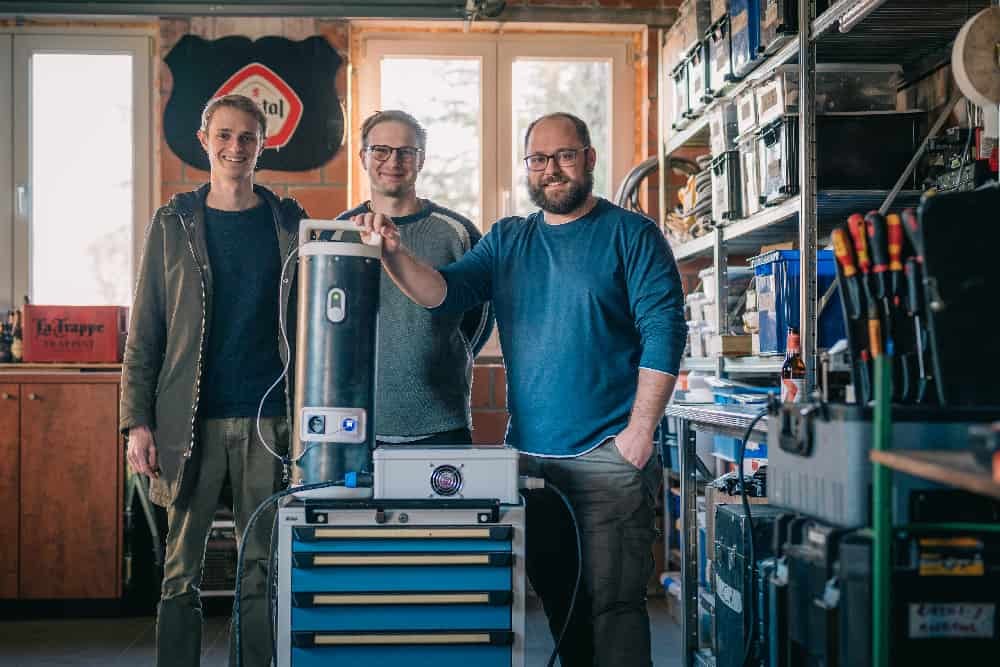
About MyGrid
- Founders: Kristof Geerts (CTO) and Jan Wellens (CEO)
- Founded in: 2022
- Employees: The start-up currently has no employees, but they have a diverse team of experts in marketing, product design, electronics, AI and software development.
- Money raised: A €75,000 capital has been raised. An additional investment of €500,000 is being sought to get the ModuleOne into series production.
- Ultimate goal: To be able to put the ModuleOne under the Christmas tree of all contributors to the crowdfunding campaign by the end of 2023.
Start-up MyGrid from the Belgian town of Diest has developed a new battery that enables you to store at home your own power supply that you generate with solar panels. Because the company managed to produce the first prototype with ‘Prototyping the Future’ funding from the Belgian Foundation for Future Generations, things kicked into gear. The start-up now plans to launch a crowdfunding campaign to hit the European market early next year. In this instalment of start-up of the day, founder Jan Wellens talks more about the company to us.
Who came up with the start-up?
“Myself and my classmate Kristof, who I went to university with. We were research partners there. We studied Industrial Engineering/Electronics at KU Leuven. We each went our own way after graduating and Kristof went to work abroad. I was involved in developing a battery for a solar car. We met up again later on. It was important to us to make a product that could contribute something positive to the world. So, after a few brainstorming sessions, we decided to develop a new home battery together.”
What does this home battery involve?
“Ease of use and simplicity were at the core of the development of the ModuleOne. The unique thing about the ModuleOne, is that you can just plug it into any power socket. No more fiddling around with its installation, just plug-and-play. Through this easy and flexible solution, we want to enable everyone, including tenants and residents of apartment buildings, to play their own part in the energy transition and take control of their own power supply. And to do that without any major investments.”
What makes this battery different from existing models??
“At present, home batteries are mainly being installed as a way to store your self-generated energy. On the other hand, we also see that the energy landscape is evolving and new energy mechanisms are also being introduced to help facilitate the energy transition. One of these mechanisms is peak load. This entails people paying a surcharge on their peak consumption. An example of this is the capacity tariff that they want to introduce in Flanders in early 2023.”
Are there any other mechanisms?
“Another mechanism is the dynamic tariff where you pay a different energy price per hour. So you can save money by being more conscious about switching on and off your heavy energy consumers. In the case of a home battery, it can be charged when energy is cheap and discharged when it is expensive. What’s more, all kinds of energy communities are emerging, where you can share energy virtually. So all kinds of new use cases are emerging, which are also interesting for home batteries with a smaller capacity. Our mission is for everyone to be able to reap the benefits of these new developments. Even people who until now have been unable to install a battery. For example, because they live in an apartment, or because they are tenants and do not have access to electrical installations. Now, thanks to the easy installation and flexibility of the ModuleOne, they can still participate in the energy transition without too many hassles.”
What is your goal?
“By 2050, the EU wants to be completely transitioned over to a fully sustainable and renewable energy supply. But if we are to switch over 100% to a sustainable and renewable energy supply by 2050, all 186 million households in the EU will also need to be able to be involved in this energy transition. Unfortunately, much of the market is in no position to do that. Just think of residents living in apartment flats, or those who rent. That’s around 90 million households in the EU, or 46.2 percent of the total EU population. If we want to make the energy transition a success, we will all need to work together to build a new and smart energy grid. That is why we believe our solution can help the energy transition.”
What steps will you be taking next?
“We are currently testing our first functional prototypes. We can also use these prototypes to define the framework conditions more precisely and map out market demand even better. The next step now is to further develop and industrialize the full product, which is still in the prototype phase at the moment. We also want to be able to mass-produce the ModuleOne as a production series and market it by the end of next year. We do notice that there is a lot of interest in our product right now, partly due to the soaring energy prices.”
Is it an environmentally friendly battery?
“Thanks to our battery, you will be CO2-neutral after just one year. The raw materials we use (lithium iron phosphate) are ecological and environmentally friendly. The battery pack can be easily taken apart and recycled. The casing is really robust and hard-wearing. This way, the product’s lifespan is extended as long as possible. The long-term environmental impact is minimal. If the battery loses too much of its capacity, we can still use it as energy storage for larger modules. For battery recycling, we can turn to Umicore. They are really advanced in that.”

Each day, Innovation Origins puts a start-up in the spotlight. Read them all here..

